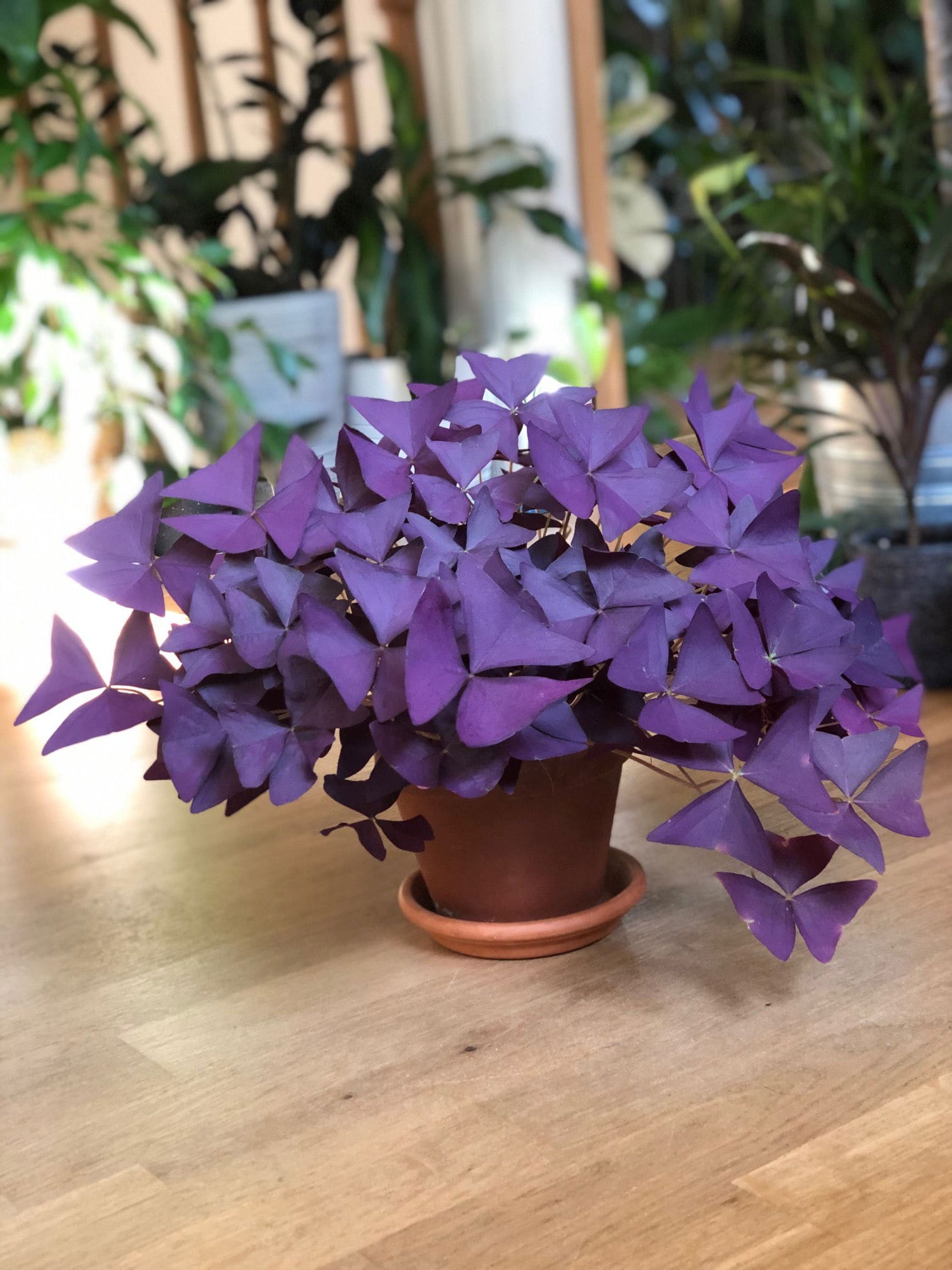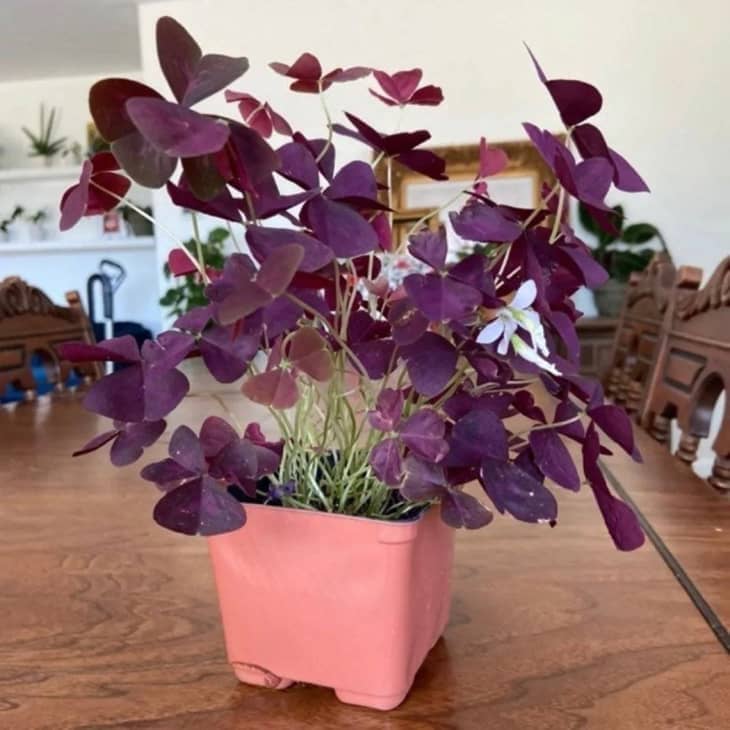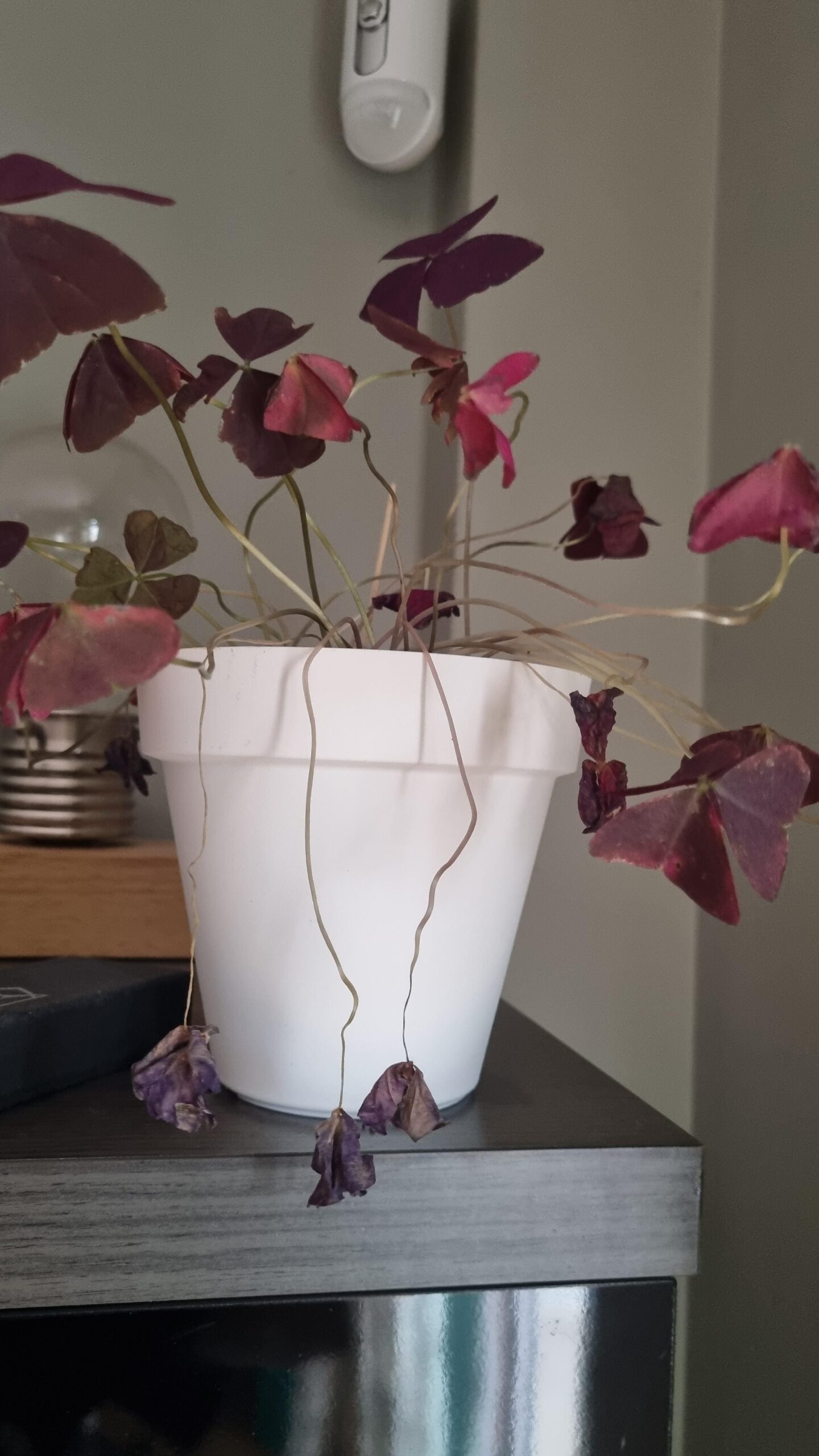As I gently brushed my fingers across the velvety purple leaves of my Oxalis triangularis, I couldn’t help but smile at the way they folded inward at my touch—almost like a living creature responding to affection.
It was this enchanting plant that first sparked my passion for houseplants years ago, and it continues to captivate me with its magical qualities and surprising resilience.
Whether you call it False Shamrock, Love Plant, Purple Shamrock, or Purple Wood Sorrel, this charming botanical wonder offers a unique combination of stunning foliage, delicate flowers, and fascinating movements that make it a standout addition to any plant collection.
In this comprehensive guide, I’ll share everything you need to know about caring for, propagating, and enjoying this remarkable plant.
Meet the Enchanting Oxalis Triangularis
- Botanical Name: Oxalis triangularis (previously known as Oxalis regnellii)
- Family: Oxalidaceae (wood sorrel family)
- Origin: South America, primarily Brazil
Oxalis triangularis is a rhizomatous herbaceous perennial that has captivated plant enthusiasts with its distinctive triangular leaves that grow in groups of three, resembling butterflies or shamrocks. While it’s often sold around St. Patrick’s Day as a “shamrock plant,” it’s not related to true shamrocks or clovers despite the visual similarity.
What truly sets this plant apart is its photophilic nature—the leaves open wide during daylight hours to maximize sun exposure and fold closed at night or when disturbed, creating a daily dance that’s mesmerizing to witness.
This natural phenomenon, known as nyctinasty, occurs when the plant senses changes in light quality through specialized receptors, triggering a response in the pulvini (joints at the base of the leaflets) that causes the characteristic folding movement.

Distinctive Features and Varieties
The Colorful Palette
While the deep purple variety is most popular, Oxalis triangularis comes in several stunning forms:
- Purple/Burgundy – Deep purple to nearly black triangular leaves with a velvety appearance
- Green – Bright green triangular leaves, often with lighter green patterns
- Variegated – Purple or green leaves with pink, white, or cream patterns (rarer and more sought-after)
Notable Cultivars
- ‘Atropurpurea’ – Deep purple leaves with a wide black border and light pink summer flowers
- ‘Charmed Wine’ – Deep purple leaves with contrasting white flowers
- ‘Ebony’ – Purple-black leaves with white flowers that transition to pink as they mature
- ‘Fanny’ – Olive green leaves with silver patterning and soft pink flowers
- ‘Francis’ – Bright purple leaves with light lavender fall flowers
- ‘Mijke’ – Deep purple leaves with mauve flowers in spring and summer
Explore Silver and Gray Foliage Plants for Stunning Gardens
Flowering Beauty
Unlike many houseplants grown primarily for foliage, Oxalis triangularis readily produces delicate, five-petaled flowers in white, pink, or lavender hues that rise above the foliage on slender stems. With proper care, these charming blooms can appear throughout the growing season, creating a fairy-like display above the lush triangular leaves.
The first time my Oxalis flowered, I was surprised by how quickly the flower stalks emerged—seemingly overnight—and how the dainty blooms seemed to float above the purple foliage like tiny butterflies. These flowers, like the leaves, close at night and reopen with the morning light, adding another layer of movement to this already dynamic plant.
Learn How to Make Orchids Rebloom: Complete Care Guide & Tips
Comprehensive Care Guide
Light Requirements
Oxalis triangularis thrives in bright, indirect light but can adapt to various light conditions:
- Indoors: Place near a south or west-facing window where it will receive bright indirect light. It can tolerate some direct morning sun but should be protected from harsh afternoon rays.

- Outdoors: If grown outside, provide partial shade, especially in hot climates. Too much direct sun can scorch the delicate leaves.
I’ve found that my Oxalis grows most vibrantly when placed about three feet from an east-facing window, where it receives gentle morning light but is protected from intense afternoon sun. The leaves fully open during the day and close as evening approaches—a reliable natural clock!
Explore The Best Air-Purifying Indoor Plants That Thrive Without Direct Sunlight
Watering Wisdom
Finding the perfect watering balance is key to keeping your Oxalis happy:
- Allow the top inch of soil to dry out between waterings
- Water thoroughly until it drains from the bottom of the pot
- Reduce watering significantly during dormancy periods
- Avoid waterlogged soil, as this can quickly lead to root rot
One watering trick I’ve discovered is to observe the leaves—when they begin to droop slightly (not from their normal nightly closure), it’s usually a sign they’re ready for a drink. After watering, they perk up remarkably fast, often within hours.
Soil and Potting
Oxalis triangularis isn’t particularly fussy about soil but performs best in:
- Well-draining, loamy potting mix
- A mixture of regular potting soil with added perlite or sand for drainage
- Slightly acidic to neutral pH (6.0-7.0)
For container growing, choose a pot with adequate drainage holes that’s just slightly larger than the root ball. Oxalis actually blooms better when slightly root-bound, so don’t rush to repot into an oversized container.
Learn How to Grow and Care for Pot Mums With this Comprehensive Guide
Temperature and Humidity
This adaptable plant is comfortable in typical home environments:
- Ideal temperature range: 60-75°F (15-24°C)
- Can tolerate cooler temperatures down to 50°F (10°C)
- Prefers moderate humidity but adapts to average home conditions
- Protect from drafts, heaters, and air conditioners
During winter months when indoor heating can create dry conditions, I place my Oxalis near other plants or use a small humidifier to maintain adequate moisture in the air. This helps prevent crispy leaf edges while promoting healthy growth.
Learn How to Care for Poinsettias And Keep Your Holiday Plant Healthy Year-Round
Fertilizing Schedule
Oxalis triangularis benefits from regular but modest feeding:
- Use a balanced, water-soluble fertilizer diluted to half the recommended strength
- Feed every 3-4 weeks during active growth (spring through fall)
- Withhold fertilizer during dormancy periods
- Overfertilizing can lead to leggy growth, so err on the side of less rather than more
Seasonal Care Adjustments
Spring (Growth Resurgence):
- Resume regular watering as new growth appears
- Begin fertilization schedule
- Move to brighter location if it was in a lower-light winter spot
- Repot if necessary (best done in early spring)
Summer (Peak Growth):
- Monitor watering needs more closely, as soil may dry faster
- Provide some protection from intense afternoon sun
- Watch for signs of heat stress if temperatures exceed 80°F (27°C)
Fall (Growth Slowing):
- Gradually reduce fertilizing frequency
- Adjust watering as growth slows
- Watch for potential signs of dormancy
Winter (Potential Dormancy):
- Significantly reduce watering if dormant
- Hold fertilizer until new growth appears
- Maintain bright light when possible
- Keep away from cold drafts and heating vents
The Dormancy Dance: Understanding Rest Periods
One of the most misunderstood aspects of Oxalis care is its dormancy period. While alarming to new plant parents, this natural resting phase is completely normal and temporary.
Recognizing Dormancy Signs
- Slowing or stopping of new growth
- Yellowing and wilting of existing leaves
- Leaves and stems eventually dying back to the soil
- Most commonly occurs in late summer or winter, though timing can vary
The first time my Oxalis went dormant, I was convinced I’d killed it. All the leaves withered and died back completely, leaving nothing but bare soil in the pot. I nearly threw it out, but something made me keep watering it (sparingly) for a few more weeks.
To my amazement, tiny purple shoots began emerging from the soil about a month later, and within weeks, my plant was fuller and more vibrant than ever before!

Dormancy Care
- Reduce watering to just enough to keep the soil from completely drying out (about once every 3-4 weeks)
- Move the pot to a cooler location (55-65°F/13-18°C)
- Stop fertilizing completely
- Be patient—dormancy can last from a few weeks to a few months
Post-Dormancy Revival
- When new growth appears, gradually increase watering
- Move back to a brighter location
- Resume normal fertilizing schedule once several leaves have emerged
- Remove any remaining dead foliage
Propagation: Creating More Magic
Propagating Oxalis triangularis is surprisingly easy and rewarding, with two primary methods:
Division Method
- Timing: Best done during active growth in spring or early summer
- Preparation: Water the plant a day before to reduce stress
- Process:
- Carefully remove the plant from its pot
- Gently separate the corms (bulbous structures) and roots
- Ensure each division has at least 2-3 corms with some roots attached
- Plant each division in a small pot with fresh potting mix
- Water thoroughly and place in bright, indirect light
- Aftercare: Keep soil consistently moist until new growth appears

Bulb/Corm Propagation
- Identifying bulbs: Small, scaly structures resembling tiny pinecones
- Planting:
- Place bulbs 1-2 inches deep in well-draining soil
- Position with the pointy end facing up
- Space multiple bulbs 3-4 inches apart
- Water lightly after planting
- Growth timeline: New shoots typically appear within 3-4 weeks
- Success rate: Nearly 100% with healthy bulbs
I’ve successfully propagated my original Oxalis into gifts for at least five friends over the years. One of my favorite moments was watching my neighbor’s face light up when I presented her with a small pot of purple Oxalis that had grown from a division of my plant.
Six months later, her plant was flourishing and had even begun producing its own delicate pink flowers!
Common Problems and Solutions
Pest Issues
Spider Mites:
- Signs: Fine webbing, stippled leaves, overall decline
- Solution: Increase humidity, spray with insecticidal soap, or neem oil solution
Aphids:
- Signs: Sticky residue, distorted new growth, visible tiny insects
- Solution: Rinse with strong water spray, apply neem oil or insecticidal soap
Mealybugs:
- Signs: White cottony masses in leaf axils and undersides
- Solution: Remove with alcohol-dipped cotton swab, treat with insecticidal soap
Learn To Master Natural Pest Control: Top Organic Solutions for Your Garden
Disease Concerns
Powdery Mildew:
- Signs: White powdery coating on leaves
- Solution: Improve air circulation, reduce overhead watering, apply fungicide if severe

Root Rot:
- Signs: Wilting despite moist soil, yellowing leaves, mushy stems
- Solution: Reduce watering, repot in fresh soil if severe, remove affected roots
Environmental Stress
Leaf Scorch:
- Signs: Brown, crispy leaf edges or patches
- Cause: Too much direct sun or low humidity
- Solution: Move to more suitable location, increase humidity
Learn How to Identify and Fix Brown Spots on Your Snake Plant
Leggy Growth:
- Signs: Elongated stems, sparse foliage
- Cause: Insufficient light
- Solution: Provide brighter conditions, rotate plant regularly
Toxicity Awareness
Oxalis triangularis contains oxalic acid, which can be toxic if consumed in large quantities:
- Keep away from curious pets and children
- Symptoms of ingestion include mouth irritation, drooling, vomiting, and diarrhea
- Most pets avoid the plant due to its bitter taste
- Mild to moderate toxicity—rarely fatal but should be taken seriously
Learn about Creating a Dog-Friendly Garden: Smart Design Tips for Pet Owners
Creative Uses and Display Ideas
Stunning Standalone
The dramatic foliage and compact growth habit make Oxalis triangularis a perfect specimen plant:
- Display in a simple, elegant pot that complements the leaf color
- Place on a bright windowsill where the daily leaf movements can be observed
- Use as a living table centerpiece during its flowering period
Striking Combinations
Oxalis triangularis plays well with other houseplants for dramatic arrangements:
- Pair purple varieties with silver-leaved plants like Pilea aluminum for metallic contrast
- Combine with trailing plants like string of pearls for textural variety
- Group with other prayer plants (Calathea, Maranta) that share similar movement patterns
Outdoor Applications
In suitable climates (USDA zones 8-11), Oxalis makes a stunning garden addition:
- Use as a colorful ground cover in partially shaded areas
- Plant in containers with spring bulbs for extended seasonal interest
- Incorporate into fairy gardens or miniature landscapes
- Edge garden pathways with its compact form

FAQs About Oxalis Triangularis
- Q: Why are my Oxalis leaves closing during the day?
A: Leaves typically close at night or in low light. Daytime closure could indicate insufficient light, temperature stress, or the plant’s response to being touched or disturbed.
- Q: My Oxalis died completely. Should I throw it away?
A: Don’t discard it! Oxalis often enters dormancy where all foliage dies back but the bulbs remain viable underground. Keep the soil barely moist and be patient—new growth will likely appear within a few weeks to months.
- Q: How long do Oxalis plants live?
A: With proper care, Oxalis triangularis can live for many years, typically 3-5 years, though some specimens have been known to thrive for a decade or more.
- Q: Can Oxalis grow outdoors year-round?
A: In USDA zones 8-11, it can grow outdoors year-round. In colder regions, it should be grown as a houseplant or brought indoors before frost.
- Q: My plant is constantly producing flowers that die quickly. Is something wrong?
A: This is normal flowering behavior! Individual Oxalis blooms last only a few days, but healthy plants continuously produce new flower stalks throughout the growing season.
- Q: How can I make my green Oxalis turn purple?
A: You can’t change a green variety to purple. The color is genetic, not environmental. If you want purple foliage, you’ll need to purchase a purple variety.
Conclusion: Why Oxalis Deserves a Place in Your Collection
After years of growing various houseplants, I still find myself drawn to my Oxalis triangularis with its perpetual dance of leaves and delicate flowers. There’s something profoundly satisfying about a plant that responds so visibly to its environment—closing its leaves at night as if going to sleep and opening them again with the morning light.
Beyond its visual appeal, this plant teaches valuable lessons about resilience. Just when you think it’s gone forever, it surprises you with new growth, reminding us that rest and rejuvenation are essential parts of any living thing’s cycle.
Whether you’re a seasoned plant parent or just beginning your green journey, Oxalis triangularis offers the perfect combination of distinctive beauty, fascinating behavior, and forgiving nature. Give this magical plant a place in your home, and I’m confident it will charm you just as it has charmed plant enthusiasts around the world.
Have you grown Oxalis triangularis or another Oxalis variety? Share your experiences and questions in the comments below—I’d love to hear how this remarkable plant has enchanted your space!
